Copywriting is hard.
Really hard, in fact.
I’ve been writing for 10 years and still believe I have a lot to learn.
That’s why practicing is so important.
Writing is a skill like any other, and that means you have to keep sharpening the ax to get better.
If you only write on occasion, it’ll slow growth.
Writer’s block hits you in the face, motivation takes a nosedive, and the list goes on: You know what I’m talking about.
Let’s solve that today.
I’m going to teach you ten insanely powerful copywriting exercises for beginners and veterans.
Follow along!
1. Write a dozen different headline variations
Headlines might be the most important part of your copy.
As a matter of fact, eight out of ten people only read the headline.
We’re all guilty of this at some point, but it’s much more common than you think.
We’ve become a culture of skimmers.
Practicing writing them is one of the most effective daily copywriting exercises for this reason.
You’re very rarely going to write a good headline on the first try.
That’s like playing baseball and expecting to hit a home run every time you’re at-bat. Not likely.
This exercise is very simple. Just perform the following steps:
- Write the initial headline you’d like to use. It doesn’t have to be perfect.
- Begin writing as many variations of the headline as possible.
- Repeat!
You may come up with ten, twenty, or fifty different ideas doing this.
Let it flow onto paper. (Or keyboard, most likely!)
It’ll look something like this:
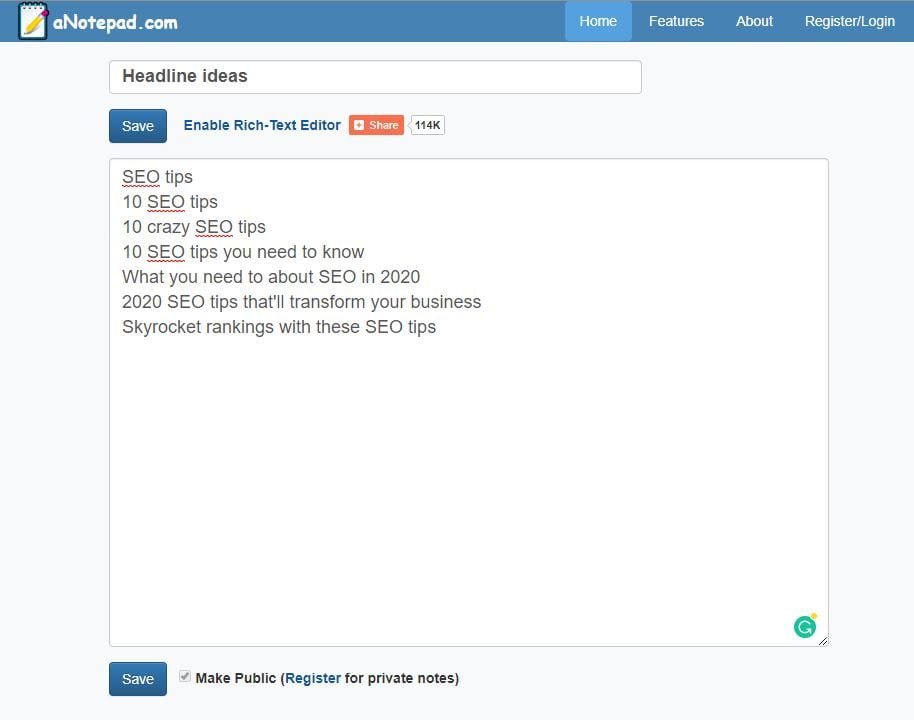
And you will look like this:
Try not to think about it. You want to use the creative and emotional side of your brain, not the analytical one.
Try using a free online notepad tool like the one I used above called Anotepad.
This copywriting exercise will result in the most unique and interesting titles. When you stop and think about it, that’s when you hit writer’s block.
Start thinking less and writing more!
I also highly recommend using a tool like Jasper.ai to write high-converting copy and get ideas lightning fast, too.
2. Re-write your favourite advertisement
Gary Halbert. Joseph Sugarman. David Ogilvy.
Those are just a few of the copywriters and advertisers who changed the world of business forever.
We use their strategies today whether we realize it or not.
They’ve written some of the best damn advertisements for the biggest companies ever. I’m talking Rolls Royce, Proctor & Gamble, the whole shebang.
Re-writing their advertisements allows you to break down their thinking, techniques, and see first-hand how they structure copy.
One of the best ways to practice this exercise is to visit Swiped.co and search for your favourite advertisers.
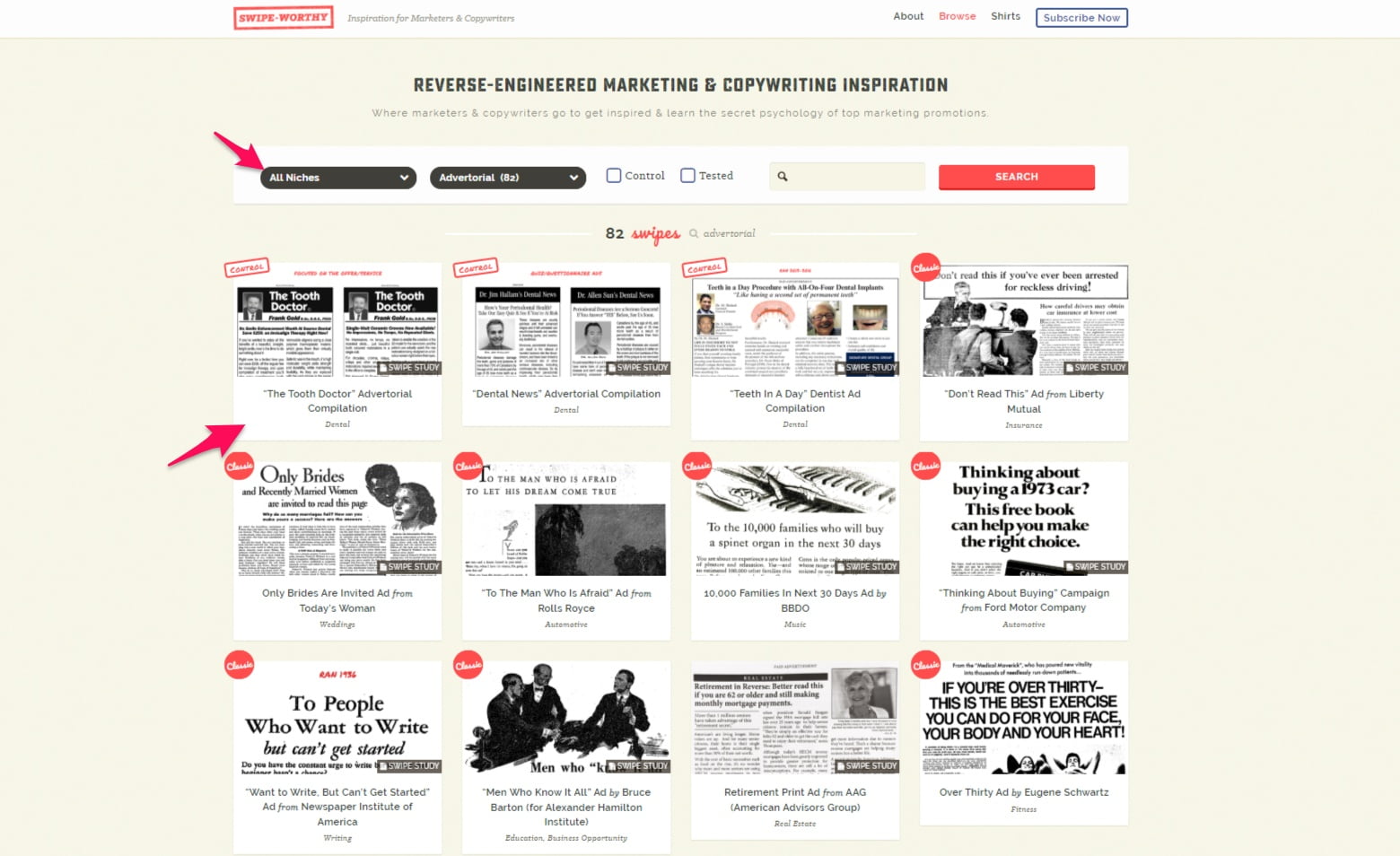
Alternatively, you can enter keywords or use the drop-down filters.
Click any advertisement, and it will bring you to the full page.

The next step is reading the advertorial to get a sense of the copy.
Then, re-write it! Have fun, and don’t take it too seriously.
The goal is to try to improve upon it and create your own unique take.
Give it a different headline. Talk about the product differently. Change the sub-titles or structure.
If you need feedback and want to seriously improve your copywriting skills, check out my copywriting mastery training.
That brings me to my next point.
3. Write as fast as humanly possible
Have you ever hit writer’s block?
You know what I’m talking about: writing ten words per hour, feeling your hair turn gray, and feeling like you might quit writing for the 100th time.
Yep, we’ve all been there.
Wanna know the cure?
Writing as fast as humanly possible.
I’m talking Lamborghini-fast.

This copywriting exercise will increase how fast you write without sacrificing quality.
And—as I mentioned earlier—writing quickly uses the creative and emotional part of the brain.
Editing after is when you can polish the structure, syntax, logical flow, etc.
Try using a words-per-minute tool like TypeRacer.

It will place text on the screen that you have to type while recording your WPM.
You can choose between competitive mode, practice, or inviting a friend.
I recommend the practice mode to begin.

Keep in mind that the average person writes 35-40 words per-minute.
You’re an Einstein of writing if you get in the 65-75 range.
Anything beyond that, and your fingers could compete in the Daytona 500.
4. Get feedback from other writers and non-writers
Two minds are better than one!
Sharing content and copy you write is an amazing way to get feedback, ideas, and inspiration.
Others will often see improvements and flaws in your writing that you don’t.
After all, it’s easy to have rose-tinted glasses with something you wrote.
It’s perfect and amazing in every single way, right?
Far from it sometimes. Especially when it comes to first drafts.
Share writing with people you know, or better yet, leverage online communities like Writing Forums.
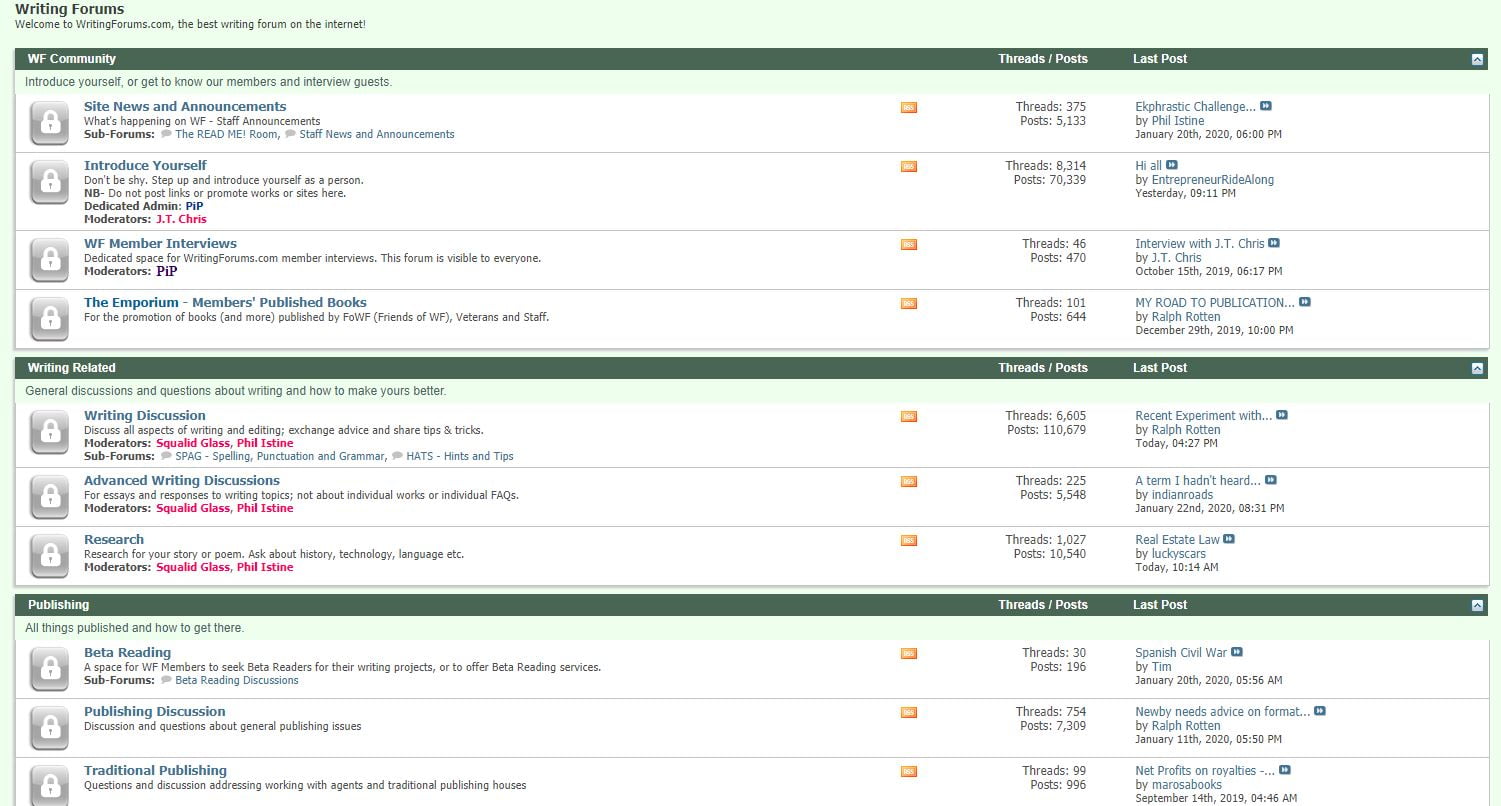
They’re a community of writers from all walks of life and industries.
Don’t worry, I was surprised that forums still exist, too!
Begin by registering from the home page.
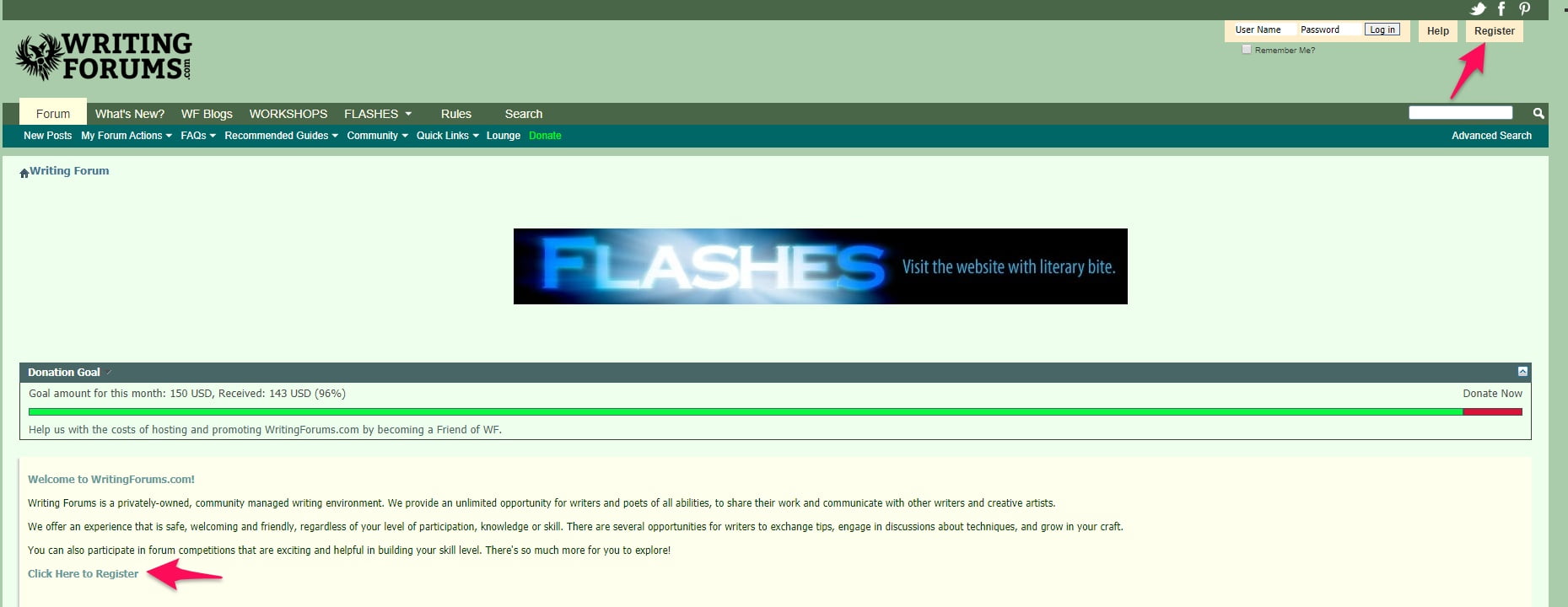
Activate your account via the email they send you and create a thread on the appropriate board.
Ask particular questions if you’re stuck on something specific. Or, see what other writers have to say about your work in general and be open to critique.
You can gain access to my new private mastermind community after enrolling in one of my online courses, so check them out while you’re at it.
5. Experiment with the introduction
The introduction is a common sticking point for writers.
It needs to stand out. It needs to get readers glued to the page.
Nonetheless, it’s much easier said than done.
A great copywriter exercise to overcome this is experimenting with how you write introductions.
I firmly believe in the use of templates and formulas because they produce effective writing and save you headaches.
Say goodbye to popping Advil every time you open up your laptop!
Instead, I recommend that you have fun with some of these introduction strategies:
- Use a bold statement: Say something readers wouldn’t expect. Make a statement that goes against the norm or your normal opinion.
- Cite an interesting statistic: Use data, charts, graphs, and similar statistics to generate interest and back up points you make.
- Ask a question: Get the reader hooked by asking a question relevant to their situation, emotions, etc.
- Paint a picture: Use vivid detail to help readers imagine a particular scenario and its related emotions.
- Give deep context: Explain the history or meaning behind what you’re speaking about.
Do you know what the best part is with these techniques? You can use one or several.
Put a twist on them and come up with unique ideas that make readers drool for more.
Write them down for later use, and every time you write an introduction, you’ll have formulas to leverage.
6. Physically write copy (It’s different, I swear!)
There’s something uber satisfying about physically writing with pen and pad.
It’s one of the reasons I love journaling every day.
Writing physical copy versus typing it out has a scientific benefit, too.
Dr. Helen Macpherson from Deakin University told The Huffington Post “When we learn new information, for example, at school or in a university lecture, we don’t write verbatim, which means we have to create our own summaries and concepts.”
Writing forces you to think deeply about a subject to summarize it and be resourceful.
This is the opposite of typing lighting fast on a laptop, for example.
Dr. Macpherson also went on to say, “The very nature of handwriting means you have to write and organize as you are thinking, and that kind of organization affects how you are interpreting the information.”
Next time you’re working on a project, try writing down copy and new ideas on a piece of paper. It’s game-changing!
7. Create several different conclusions
Endings, just like introductions, can be a real sucker sometimes.
If you write 3,000 words, it can be tough to summarize everything in 100 words, for example.
Mastering conclusions will make you a talented writer for this reason.
I like to write several different conclusions for articles and similar pieces of copy/content.
This allows me to pick from the best one, and the latter is often more refined.
You can perform this exercise after first writing the main portion of a project.
Then, summarize the main points of the body in several different ways.
Perhaps one is snappy and quick; the other could be detailed and elaborate.
You will be able to determine which one suits the material best after comparing them.
It also lets you flex your creativity muscles.
8. Create an email account to study funnels
Swipe, swipe, swipe. That’s the name of the game.
Studying what other brands and writers do is the best way to learn how to be a better writer. Hands down.
That’s why you should create a separate email account to sign up for newsletters and other funnels.
You can study copy in emails, landing pages, and more.
I recommend visiting Google and searching for phrases like:
- Copywriting course
- Copywriting book
- Copywriting e-book
- Copywriting checklist
- Copywriting cheatsheet
- Etc.
The goal is to find lead magnets that are often exchanged for an email subscription.
See how Copyblogger offers a free course if you enter your email? Bingo!
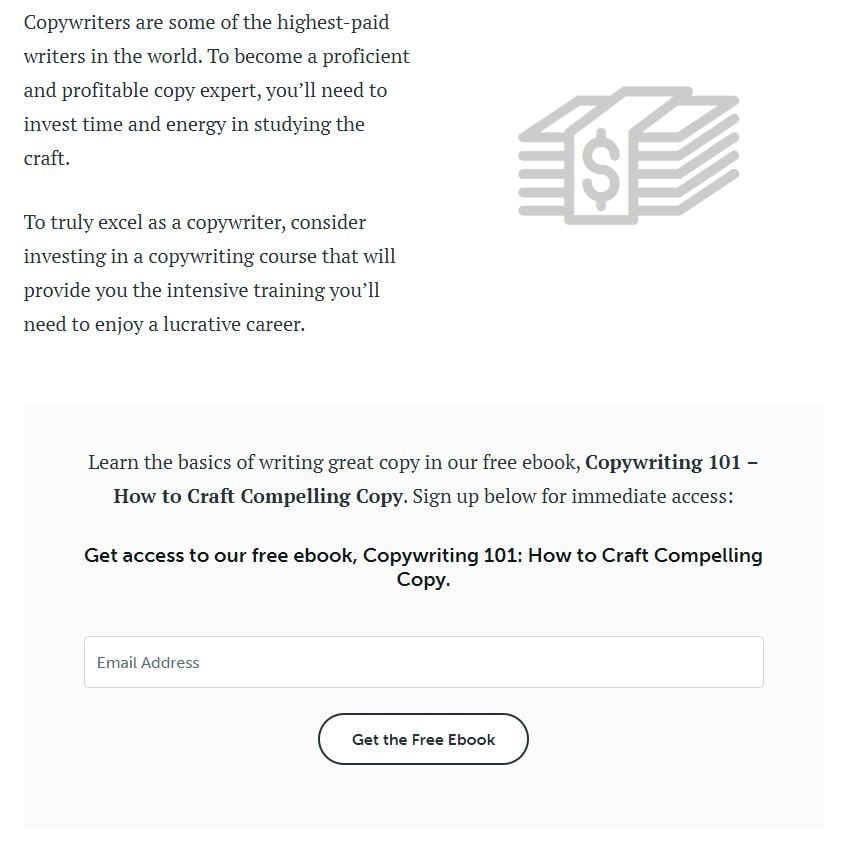
Let’s imagine you sign up. You’d receive newsletters, offers, and other emails that you can study.
What calls to action do they use? What tone of voice? Who is the target audience?
Ask questions like these to uncover their strategies that can be stored in your writing toolbox for later.
9. Keep an eye out while in the real world
I love doing this.
The idea is that while you’re out and about, don’t let advertisements fly by.
We see an average of 63 display ads per day.
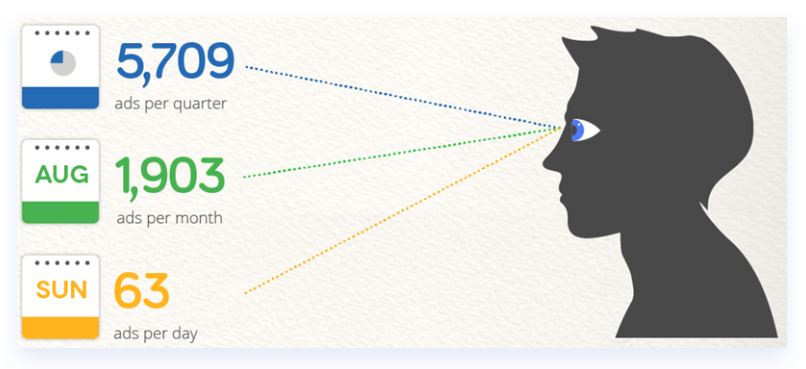
That’s not counting what we see during daily commutes, going to the gym, etc.
You’re passing by signs, billboards, hearing ads on the radio. It just doesn’t stop!
However, as a copywriter and marketer, it’s a brilliant opportunity.
Instead of tuning them out or thinking, “Mmm, that $1 McChicken sounds good,” you should rip them apart.
Are they using calls to action?
What power words are they using?
Which copywriting strategies can you recognize they’re using? (Think FOMO, urgency, scarcity, etc.)
This is a great way to constantly keep you sharp. It also serves as excellent inspiration.
10. Write. Every. Day.
I write a few thousand words per day, and I still believe I have lots to learn as a copywriter.
Writing well is like being Lebron James.
You’re not going to get good without shooting 10,000 shots first.
You’re a writer, correct? Then, you need to be writing!
And every day at that.
It doesn’t matter if it’s client projects, a blog, or strictly for fun.
Just write. Don’t overthink it.
Set a word count goal if you wish. Check out the subreddit /r/wordcount if you go this route.

It’s a nice community to get inspiration and motivation.
You make a thread with the desired word count goal of the day or with how many you’ve already reached.
Make sure to read my list of the best writing subreddits on that note.
11. AIDA copywriting challenge
Wanna snag your reader’s attention like a pro? Let’s break down the AIDA Formula Challenge into bite-sized pieces. It’s like a workout for your copywriting muscles.
1. Grab Attention: Start with the “Attention” part. Think of your headline as the flashy neon sign that says, “Hey, look over here!” You’ve got, like, 5 seconds tops. No pressure, right? Try using shock value, a crazy stat, or a bold promise to make those eyeballs stick.
2. Pique Interest: Next up, “Interest.” Here’s where you become a storyteller. Hook ’em with an opening line that hits where it hurts – their pain points. Stir curiosity. Make ’em think, “Hmm, tell me more!”
3. Build Desire: Now, we’re onto “Desire.” This is where you show off those shiny benefits like they’re diamonds. Bullet points are your best friend here. Make each one count. Ask yourself, “Why would I buy this?” That’s what your reader’s thinking.
4. Call to Action: Lastly, “Action.” You’ve warmed them up; now, it’s time to close the deal. Your call-to-action (CTA) should be like a friendly nudge saying, “C’mon, you know you want to.”
Keep it simple. Keep it punchy. And most importantly, make it irresistible.
12. The PAS (Pain-Agitate-Solve) Copywriting Exercise
To complete this exercise, choose a real or fictional product or service and then follow these steps.
1. Spot the Problem: First off, identify a problem. Not just any problem, but THE problem. The one that keeps your audience up at night. This is the “What’s bugging you?” part. Be specific. The more you narrow it down, the more your reader will nod along and say, “Yep, that’s me.”
2. Agitate Like There’s No Tomorrow: Now, don’t just poke at it—agitate it. Think of it as salt on a slug (ouch). You want to dive into why this problem is a big deal. Paint a picture of the struggle. Make it so real that they feel it in their gut. But hey, don’t go overboard. We’re not trying to depress anyone here.
3. Present the Perfect Solution: Finally, bring in your superhero—your solution. After all that agitating, your solution should feel like a cool breeze on a hot day. This is where you shine, offering the answer they’ve been searching for. It’s not just a product or a service; it’s the light at the end of their tunnel.
13. Email Subject Line Exercise
Here’s a great exercise that will level up your email marketing skills. Pretend you writing an email campaign and complete these steps.
1. Craft Multiple Contenders: Kick things off by brainstorming a bunch of subject lines. Think of each one as a mini-ad for your email. You want to be clever, but clear. Curious, but not clickbaity. Whip up at least two variations that you think will turn heads.
2. Test Small, Think Big: Got your contenders? Great. Now, let’s not go emailing your whole list just yet. Pick a small segment of your audience and split it in half. One subject line goes to group A, the other to group B. This is your mini-battlefield where subject lines duel it out.
3. Measure the Madness: Send out your emails and watch closely. Which subject line gets more opens? Which one’s getting the cold shoulder? This is where the magic of data comes into play. Numbers don’t lie, folks.
4. Roll Out the Winner: Now, for the moment of truth. Take the subject line that came out on top and send it to the rest of your list. This is your champion, the one that’s going to rake in those opens.
14. Twitter Pitch Practice
Here’s a fun one. The idea is to get better at creating an elevator pitch by condensing your offer into the length of a tweet.
1. Squeeze Your Message: Start with the meat of your message. Can you say it in one sentence? That’s your goal. Think of it like a tweet-sized elevator pitch. No fluff, no filler, just value.
2. Hook ‘Em Fast: You’ve gotta hook your readers instantly. Use power words, stats, or questions. It’s like the first line of a great story. Make them want to click that link or smash that like button.
3. Emojis and Hashtags: Sprinkle in some emojis for flavor. 🚀 They’re the body language of the internet. And don’t forget hashtags. They’re your SEO in the Twitterverse. But keep it to two or three max. #NoSpamHere
4. Test, Tweak, Repeat: Shoot out a few different tweets for the same thing. Test different hooks and calls-to-action. See what sticks. Twitter’s fast-moving, so you can play around. Analyze those likes, retweets, and clicks.
15. Objection Handling Exercise
Want to get better at sales and copywriting all at once? Try out this exercise to handle the objections of your customers.
1. List ‘Em Out: Grab a pen and jot down every “Yeah, but…” you’ve ever heard about your product. We’re talking fears, concerns, and straight-up disbelief. These are your objections, and they’re gold. Why? Because they’re real.
2. The ‘But Why?’ Game: For each objection, ask yourself, “But why?” Get to the heart of it. Is it price? Is it trust? Understand the “why,” and you’re halfway to handling it.
3. Craft Your Counter-Attack: Now, for each “Yeah, but…” craft a comeback that’s as smooth as butter. Use facts, testimonials, guarantees. Whatever it takes to show your reader that this objection is a non-issue.
4. Keep It Real: Be honest. Don’t dodge. If the objection is legit, acknowledge it. Then explain how the value outweighs the concern. Transparency is key.
Final thoughts on daily copywriting exercises
If you want to be the Stephen King of copywriting, there’s no other way than to grind.
Use the copywriting exercises I covered today to 10x your writing and make it a daily habit.
Small habits compound, and you’ll feel gitty when you see how much better you’re becoming over time.
Feel free to get mentorship and learn how to build an online writing business in my courses as well.
What writing exercises are your favorite?














